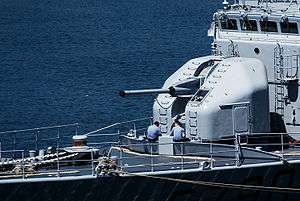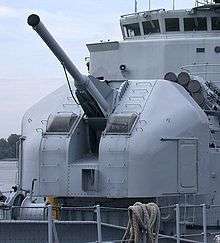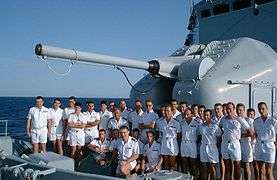French 100 mm naval gun
Modern French 100 mm naval guns are multipurpose artillery pieces (anti-air, anti-ship, and shore bombardment), capable of a high rate of fire. Most modern French warships are/were equipped with one of its versions.
| Canon de 100mm | |
|---|---|
 100 mm turret on Lieutenant de vaisseau Lavallée | |
| Type | Naval gun |
| Place of origin | France |
| Service history | |
| In service | 1958–present |
| Used by | France, Belgium, Portugal, Turkey, Brazil, Saudi Arabia, Taiwan, Bulgaria |
| Wars | Gulf war |
| Production history | |
| Designer | Tonnelé |
| Designed | 1953 — 1961 |
| Manufacturer | GIAT |
| Produced | 1961 — present |
| Variants | modèle 53 modèle 64 modèle 68 modèle 100 TR |
| Specifications | |
| Mass | 22 metric tons |
| Barrel length | 55 calibres |
| Crew | 2 (modèle 68) ; later version entirely automatic |
| Shell | 100 x 700mm .R |
| Calibre | 100 mm |
| Elevation | 29°/s |
| Traverse | 40°/s |
| Rate of fire | 78 round/min |
| Muzzle velocity | 870 m/s |
| Effective firing range | 17,000 m (elevation 40°) Maximum practical range:
|
History
At the end of the Second World War, the French Navy was equipped with guns of numerous calibres, most of which were obsolete. In 1953, the STCAN of Paris, under engineer Tonnelé, drafted the design of a multi-purpose 100 mm gun. The gun was designed to be effective for
- anti-aircraft defence
- anti-ship combat
- shore bombardment
The first model of the family, "modèle 53", was tested at sea on the escort Le Brestois in 1958 and the escort aviso Victor Schoelcher in 1961.
Description
The most common version, modèle 68, features a completely automatic action and control. The ammunition is stored in a magazine underneath the turret, and fed to the gun by a lift regularly manned by two crewmen. A flexible pipe allows feeding the gun under any orientation.
Rounds of ammunition are fed automatically; after firing, the empty shell casing is ejected through an evacuation door on the front of the turret. Cooling is provided by water circulating in layers of steel around the tube of the gun, and by an injection of air and water after every shot.
The turret can be used in three modes:
- Remote control by the main weapon control system, from the Operation Center
- Remote control from a secondary weapon control system
- Manual control by the joystick at the left of the gun (except the 100TR version)
In manual mode, two crewmen serve the turret: the gunner, at the left of the gun, uses a joystick to point the gun, and optic ranging and aiming instruments to direct the fire; the observer monitors the operations from the back of the turret.
Aiming is performed by two electric motors, one for the elevation (left of the turret) and the other for the traverse (right of the turret). Two hydraulic systems feed the gun. The gun can also be moved manually for maintenance.
Since it is usually installed on the bow deck of warships, these turrets are often exposed to breaking waves and humidity. To prevent corrosion and mechanical problems, the turret is made water-tight with rubber joints. The muzzle itself is sealed by a rubber tampion, which can be shot through in case of emergency.
The plexiglas viewbay used to manually aim the gun is usually protected by a steel cover.
Versions
Over the years, the 100 mm turret went through several improvements, notably bringing more reliable operation and increased firing rate, new ammunition optimized to shoot down missiles, and compatibility with modern firing computers. Three main versions of French 100mm guns can be cited:
- modèle 53: the first shell had to be fed manually, with subsequent shots taking advantage of recoil to load automatically, firing at up to 60 rounds per minute. Employs electro-mechanical fire control, with two manual command stations on the front of the turret. The modèle 64 is a direct offspring of the 53, with a 78 round/min rate of fire. This version can be connected to modern firing computers.
- modèle 68 In this model, the turret was lightened and can load the first round automatically, but rate of fire is reduced back to 60 rounds per minute. This version may operate unmanned with only one manual station remaining as a backup. This version was later improved to the CADAM standard (Cadence Améliorée, "improved rate of fire"), restoring the 78 rounds/min rate of fire. A derivative is the modèle 100 TR (used on the La Fayette-class frigates), mechanically similar to the 68, but with a stealth armour. The manual control has been removed.
- Compact: This weapon has only been exported to China (see also China's Type 210 100 mm naval gun), Malaysia, Portugal and Saudi Arabia. It is even lighter than the modèle 68, at only 19 metric tons including gunhouse (14 metric ton alone), deck and magazine. Later Mk 2 versions also fire faster, at up to 90 rounds per minute. However, it is also limited to firing short bursts of no more than 6 rounds.
 100 mm modèle 53 turret of the destroyer Maillé-Brézé
100 mm modèle 53 turret of the destroyer Maillé-Brézé 100 mm modèle 64 turret of the aircraft carrier Clemenceau
100 mm modèle 64 turret of the aircraft carrier Clemenceau 100 mm modèle 68 turret on La Motte-Picquet
100 mm modèle 68 turret on La Motte-Picquet
 100 mm shell, model 1957
100 mm shell, model 1957
Usage
The 100 mm gun has been used in the French navy on most warships equal or greater than avisos (the A69 especially, built and exported in 20 units). The aircraft carrier Charles de Gaulle, with her MBDA Aster-only defence, is the main exception. Also, the future Horizon CNGF frigates are expected to be equipped with the 76 mm Oto-Melara gun. It is not yet known whether this is a general tendency to abandon the 100 mm gun, or only a special case for certain specialized vessels.
The 100 mm has been sold abroad, and is used by the navies of Argentina, Belgium, China, Portugal, Turkey, Brazil, Saudi Arabia, Bulgaria & Germany (Mounted on Köln-class frigates and Hamburg-class destroyers. Both classes are now retired), and others. Belgian Wielingen-class frigates equipped with the system were sold to Bulgaria in 2004-2008.
See also
Weapons of comparable role, performance and era
- 4.5 inch Mark 8 naval gun: contemporary standard naval gun for British ships
- 5"/54 caliber Mark 45 gun: contemporary standard naval gun for US ships
- AK-130: contemporary 130 mm twin standard naval gun mounting for Russian ships
- Otobreda 127/54 Compact and Otobreda 127/64: contemporary 127 mm naval gun from Italian manufacturer Oto Melara
External links
- (in English) NavWeaps French Naval Guns
- (in French) Le canon de 100mm (Netmarine.net)

